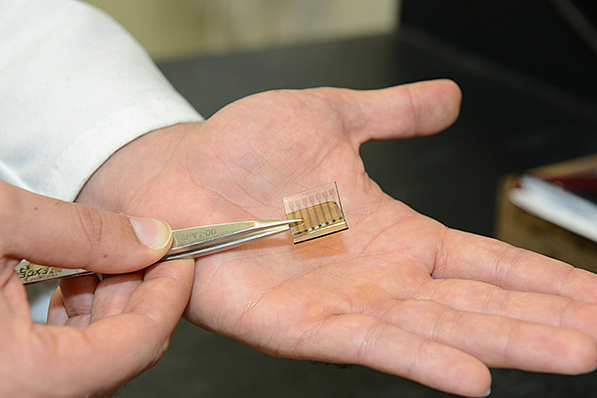Stanford Team Captures Sunlight With Carbon

This all-carbon solar cell consists of a photoactive layer sandwiched between two electrodes. | Photo: Mark Shwartz
The element carbon is at the center of our current climate change crisis: we've added a significant amount of carbon compounds to the atmosphere, especially carbon dioxide, and that increases the amount of the sun's heat the atmosphere retains. Most of the proposed solutions to the problem involve using less carbon in our daily lives. But a team of researchers at Stanford University have found a way we might be able to use carbon to help solve the climate problem: by building photovoltaic cells with the stuff.
The team, led by Stanford chemical engineering professor Zhenan Bao, has used nanotech techniques to exploit some of the properties of carbon molecules known as "fullerenes," geodesic arrangements of carbon atoms in microscopic spheres and nanotubes that -- depending on their structure -- can act as semiconductors or as efficient electrodes.
Bao has been working on the project with Stanford graduate student Michael Vosgueritchian and postdoctoral researcher Marc Ramuz. The three published their preliminary results in the October 31 issue of the journal ACS Nano, with Peng Wei of Stanford and Chenggong Wang and Yongli Gao of the University of Rochester Department of Physics and Astronomy as co-authors.
"To the best of our knowledge, this is the first demonstration of a working solar cell that has all of the components made of carbon," Bao said in a Stanford interview.
The all-carbon PV cells aren't quite ready for prime time: they've exhibited efficiencies in the range of 1%, which is about a twentieth that of commercially available photovoltaic cells. But the team's all-carbon design does offer some potential advantages over currently available PV technologies. For one thing, says Bao, the compounds used in the all-carbon PV cell can be applied to a target surface in solution, suggesting a much cheaper and more flexible range of applications. And as the team's PV cells absorb near-infrared, they can be made transparent to visible light. "Perhaps in the future we can look at alternative markets where flexible carbon solar cells are coated on the surface of buildings, on windows or on cars to generate electricity," said Bao.
What's more, early indications are that all-carbon solar cells will be resistant to conditions such as extreme temperature that would put their competitors out of commission.
Though the silicon usually used in PV cells is even more abundant on Earth than carbon, silicon PV cells require exacting manufacturing conditions. Thin film alternatives tend to use materials like tellurium and indium that can be in short supply. If Bao's team's work pays off, we might well see PV cells made cheaply and effectively out of one of the planet's most abundant substances.
ReWire is dedicated to covering renewable energy in California. Keep in touch by liking us on Facebook, and help shape our editorial direction by taking this quick survey here.


